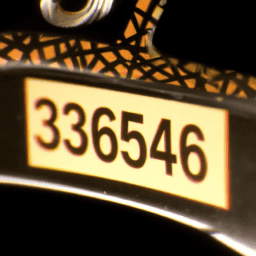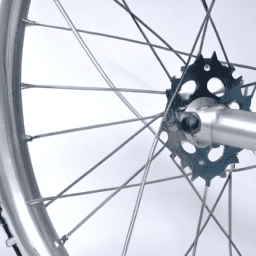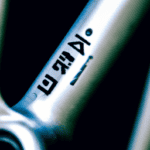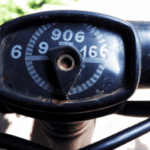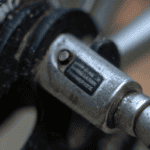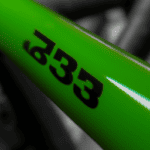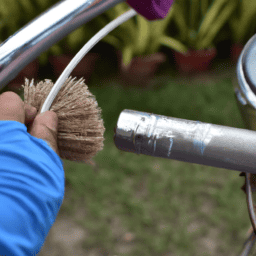You might see your bike merely as a means to travel from one place to another, yet it encompasses far more. Your bike represents an investment, a method of getting around, and a way to enjoy leisure time.
That’s why it is important to know where the serial number is located on your bike. The serial number of your bicycle acts as a unique identifier, much like a fingerprint. It is crucial in case your bike is ever stolen or lost. Knowing where to find your serial number can help you recover your bike more quickly and easily.
In this article, we will explore the common locations for serial numbers on bicycles and give you tips for keeping your serial number safe.
Key Takeaways
- Bicycle serial numbers are important for identifying stolen bikes, proving ownership, and insurance claims.
- Serial numbers can be found in common locations on bicycles, such as under the bottom bracket or on the seat tube.
- Registering serial numbers with a national database or keeping a record of them yourself can help recover stolen bikes.
- Different brands may use different numbering systems, but a knowledgeable technician can decipher them.
Importance of Serial Numbers for Bicycles
Don’t underestimate the importance of having a serial number on your bike – it can be a crucial tool in recovering your stolen ride. In fact, a serial number plays a vital role in insurance claims and police investigations. By having a unique identifier for your bike, you increase your chances of retrieving it if it gets stolen.
Without a serial number, it can be difficult to prove ownership and identify a stolen bike. In addition to insurance claims and police investigations, serial numbers are also useful for identifying stolen bikes. Bike theft is unfortunately common, and without a serial number, it can be challenging to distinguish a stolen bike from a legitimate purchase.
By registering your bike’s serial number with a national database or keeping a record of it yourself, you can help authorities return stolen bikes to their rightful owners. Now that you understand the importance of serial numbers, let’s explore the common locations where you can find them on your bike.
Common Locations for Serial Numbers
You’ll easily spot the unique identification code on your bike by checking the usual places where manufacturers typically engrave it. Here are four common locations to look for your bike’s serial number:
-
Bottom bracket: This is the metal part of the bike frame that connects the pedals. The serial number is often engraved on the underside of this bracket.
-
Seat tube: This is the tube that runs vertically from the pedals to the saddle. Manufacturers may engrave the serial number on the bottom or top portion of this tube.
-
Rear dropout: The rear dropout is the part of the frame where the rear wheel attaches to the bike. The serial number may be engraved on either side of this dropout.
-
Head tube: The head tube is the part of the frame that holds the front fork. The serial number may be engraved on the top or bottom portion of this tube.
It’s important to note that while these are the most common locations for serial numbers, some manufacturers may use alternate serial number markings. Additionally, counterfeit serial numbers may be present on stolen bikes, so it’s important to verify the authenticity of the serial number before purchasing a used bicycle.
To ensure you have the correct serial number, it’s important to know where to look. Keep reading to learn how to find the serial number on your bicycle.
How to Find the Serial Number
To locate the unique identification code on your bike, take a closer look at the metal parts that connect the pedals, run vertically from the pedals to the saddle, attach the rear wheel to the frame, or hold the front fork in place.
The serial number is typically engraved or stamped onto these areas and can be found on most bicycles. However, newer models may have the serial number printed on a sticker instead.
Knowing the serial number of your bike can aid in identifying the brand and model, especially if it’s been stolen. Different brands have different numbering systems, and a knowledgeable technician can decipher the code to determine the make and model.
Additionally, registering your bike’s serial number with the local police department can help recover it if it’s ever lost or stolen. With that in mind, let’s move on to tips for keeping the serial number safe.
Tips for Keeping the Serial Number Safe
To ensure the safety of your bike, it’s crucial to keep the serial number safe.
Start by recording and storing the number in a secure place, such as a safe or a password-protected document.
Additionally, register your bike with local authorities and use anti-theft measures to prevent theft.
By following these tips, you can increase the chances of recovering your bike in the event of theft.
Record and Store the Number in a Secure Place
Make sure you store the bicycle’s serial number in a secure place to prevent theft and facilitate recovery in case of loss. It is crucial to document your bike’s ownership, and the serial number is the most critical piece of information you need to keep. You can use the serial number to check if a bike is stolen before purchasing it and report it to the authorities. It is also necessary to record other information such as the make, model, and color of the bike, as well as any unique features that may distinguish it from others.
To help you keep track of your bike’s information, you can use the following table as a guide:
| Information | Description |
|---|---|
| Serial Number | Unique identifier for your bike |
| Make and Model | Brand and model of the bike |
| Color | The color(s) of the bike |
| Unique Features | Any distinguishing characteristics of the bike |
| Location Stored | Where you will keep the information about your bicycle |
Once you have recorded your bike’s information, make sure to store it in a secure place. This information will be invaluable if your bike is lost or stolen. However, documenting your bicycle’s ownership and storing the information is only the first step. The next step is to register your bike with local authorities.
Register Your Bike with Local Authorities
Don’t forget to register your ride with the local authorities to increase the chances of getting it back if it ever gets lost or stolen. Bike registration is a simple process that can be done online or in-person.
Most cities have a bike registration program that allows you to provide your bike’s serial number and other identifying information to the police department. Here are a few benefits of registering your bike:
- It helps the police locate and return stolen bikes to their rightful owners.
- It serves as proof of ownership in case of disputes.
- It can deter thieves from stealing your bike in the first place.
Not registering your bike may have legal implications if it’s found to be stolen, and you may not be able to recover it. Taking the time to register your bike is a small but important step in protecting your investment and increasing the chances of getting it back if it is ever lost or stolen.
Remember, registering your bike is just one part of bike theft prevention. In the following section, we’ll discuss some anti-theft measures you can take to further protect your ride.
Use Anti-theft Measures
Now that you’ve registered your bike with local authorities, it’s time to think about anti-theft measures. Bike theft is unfortunately common, but there are steps you can take to prevent it from happening to you.
One of the most effective ways to deter thieves is to use a sturdy lock. There are several types of bike locks to choose from, each with their own advantages and disadvantages. Cable locks are lightweight and easy to carry, but they can be cut with bolt cutters. U-locks are heavier and more difficult to break, but they may not fit around larger objects. Chain locks provide a balance between the two, but they can be heavy and cumbersome to carry. When selecting a lock, consider the location where you’ll be parking your bike and the level of security you need.
In addition to choosing the right lock, there are other tips for preventing bike theft. Always lock your bike to a secure object, such as a bike rack or sturdy pole. Don’t leave your bike unattended for long periods of time, especially in high-crime areas. If possible, store your bike indoors or in a secure location. Consider using a secondary lock, such as a cable or chain, to secure the wheels and frame.
By taking these steps and using the right lock, you can minimize the risk of bike theft and protect your investment.
Frequently Asked Questions
Can I change the serial number on my bicycle?
While it’s technically possible to change a bicycle’s serial number, it’s illegal and highly discouraged. The original serial number is important for theft prevention and insurance purposes, so it’s best to maintain it.
How can I register my bike’s serial number with the police?
To register your bike’s serial number with the police, first record it in a safe place. Registration helps deter bike theft and increases the likelihood of recovery. Report thefts promptly to improve recovery chances.
Does the serial number provide any information about the make or model of my bike?
Verifying the serial number of your bike is important as it can help identify the make and model. To decode a serial number, look for a manufacturer’s code, date code, and a unique identifier.
What do I do if my bike doesn’t have a serial number?
If your bike lacks a serial number, use alternative identification methods such as examining unique features and components. However, reporting a missing serial number to the manufacturer is important for theft recovery and warranty purposes.
Can I use the serial number to track my stolen bike?
To track your stolen bike, register its serial number with a serial number registry. This will increase the likelihood of it being recovered. Bike theft prevention starts with taking steps to secure your bike and having identifying information like a serial number.
Conclusion
Congratulations, you’ve successfully learned where the serial number is located on a bicycle and its importance. Now, you can easily locate the serial number on various parts of your bike, such as the bottom bracket, seat tube, and headset.
However, let’s not forget the irony of this situation. The serial number is a crucial aspect in the identification and recovery of stolen bikes. But alas, it’s often overlooked or even removed by thieves.
So while knowing where to find the serial number is essential, it’s equally important to take measures to secure your bike and prevent theft. Always lock your bike when leaving it unattended, and consider registering it with your local authorities or cycling organizations.
Remember, prevention is key in keeping your beloved bicycle safe and sound.
